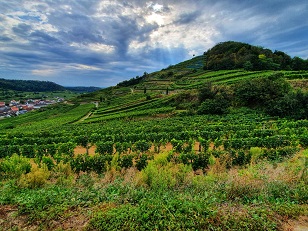Germany
 Germany has a vineyard area of around 102,000 hectares, mainly in the south-west of the country, where the climate is warmest. The three largest of the 13 cultivation areas are Rheinhessen, the Pfalz (Palatinate) and Baden. The most important and most cultivated grape variety is the Riesling . It supplies the best German white wines , which are also highly appreciated internationally. The Müller-Thurgau ranks second place, however with a still falling tendency, followed by Silvaner and the upcoming Pinot grapes (Grauburgunder und Weißburgunder).
Germany has a vineyard area of around 102,000 hectares, mainly in the south-west of the country, where the climate is warmest. The three largest of the 13 cultivation areas are Rheinhessen, the Pfalz (Palatinate) and Baden. The most important and most cultivated grape variety is the Riesling . It supplies the best German white wines , which are also highly appreciated internationally. The Müller-Thurgau ranks second place, however with a still falling tendency, followed by Silvaner and the upcoming Pinot grapes (Grauburgunder und Weißburgunder).
The classic German predicate system with the classification like Kabinett, Spätlese (late harvest), Auslese etc., is less and less used for dry wines by quality-oriented winegrowers, its getting popular to have a systemsimilar to Burgundy with Gutswein - the basic level without a village or vineyard on the label, Ortswein - with the village, and Lagenwein - with village and vineyard. The more specific the origin is, the higher the quality. The top of the dry wines is the so-called "Grosses Gewächs" or "GG", which are defined by the VDP . However, this name may only be used by VDP-members.
- €7.499.99 € / L Incl. VAT, Excl. Shipping
- €7.9510.6 € / L Incl. VAT, Excl. Shipping
- very drinkable2019 Minheimer Riesling trocken Alte Reben, Christoph Koenen
- €8.3911.19 € / L Incl. VAT, Excl. Shipping
- €8.9011.87 € / L Incl. VAT, Excl. Shipping
- €8.9011.87 € / L Incl. VAT, Excl. Shipping
- heroic cuvée2022 HEROINE Weißweincuvée trocken, Wageck - Pfalz€8.9011.87 € / L Incl. VAT, Excl. Shipping
- €8.9511.93 € / L Incl. VAT, Excl. Shipping
- €8.9511.93 € / L Incl. VAT, Excl. Shipping
- €9.2912.39 € / L Incl. VAT, Excl. Shipping
- fresh & balanced2023 Weissburgunder trocken Studier, Pfalz - bio€9.4912.65 € / L Incl. VAT, Excl. Shipping
- delicately fruity & charming2022 Grauburgunder trocken Studier, Pfalz 0,75L - bio€9.4912.65 € / L Incl. VAT, Excl. Shipping
- vineyard Lenchen2019 Riesling trocken Mineralist, H.T. Eser - Rheingau
- €9.7913.05 € / L Incl. VAT, Excl. Shipping


















